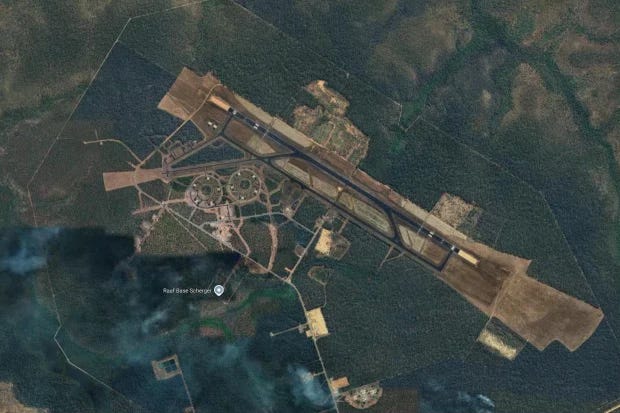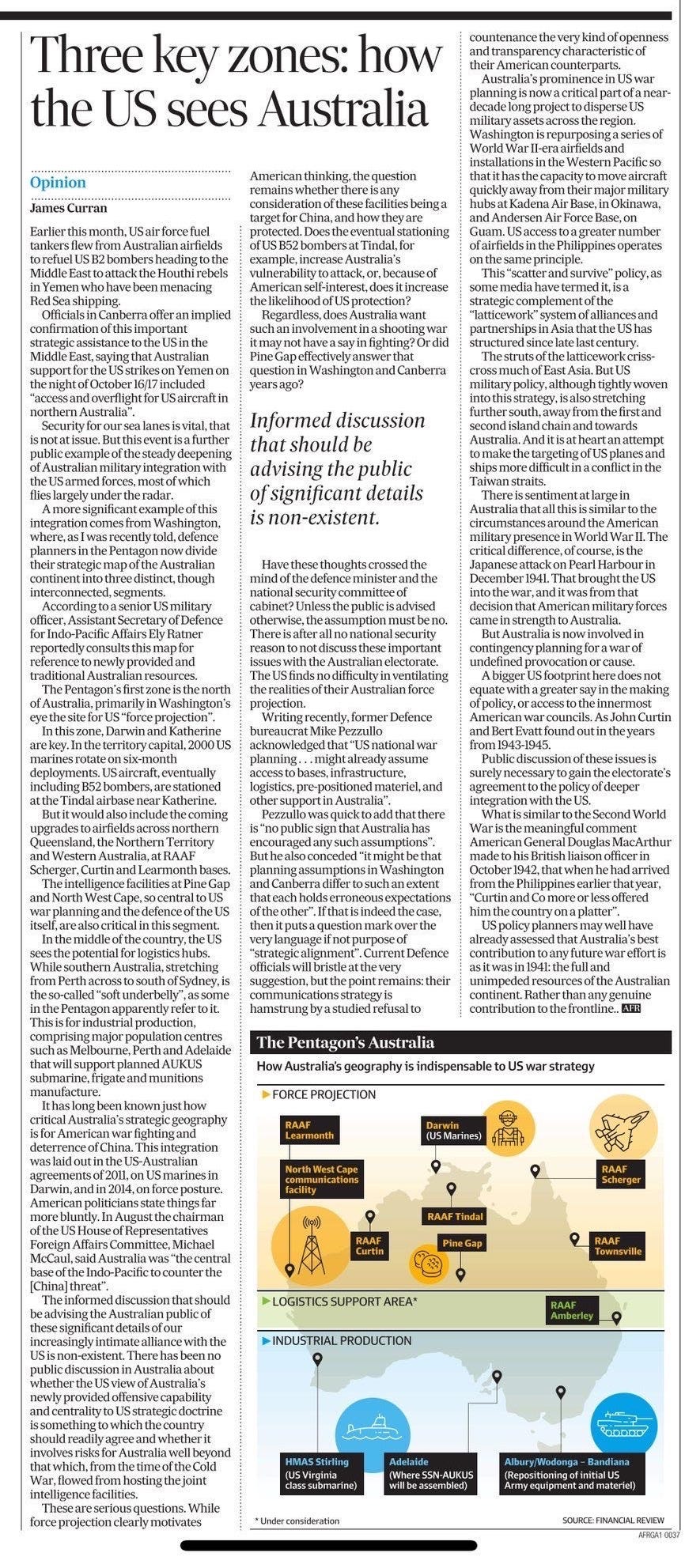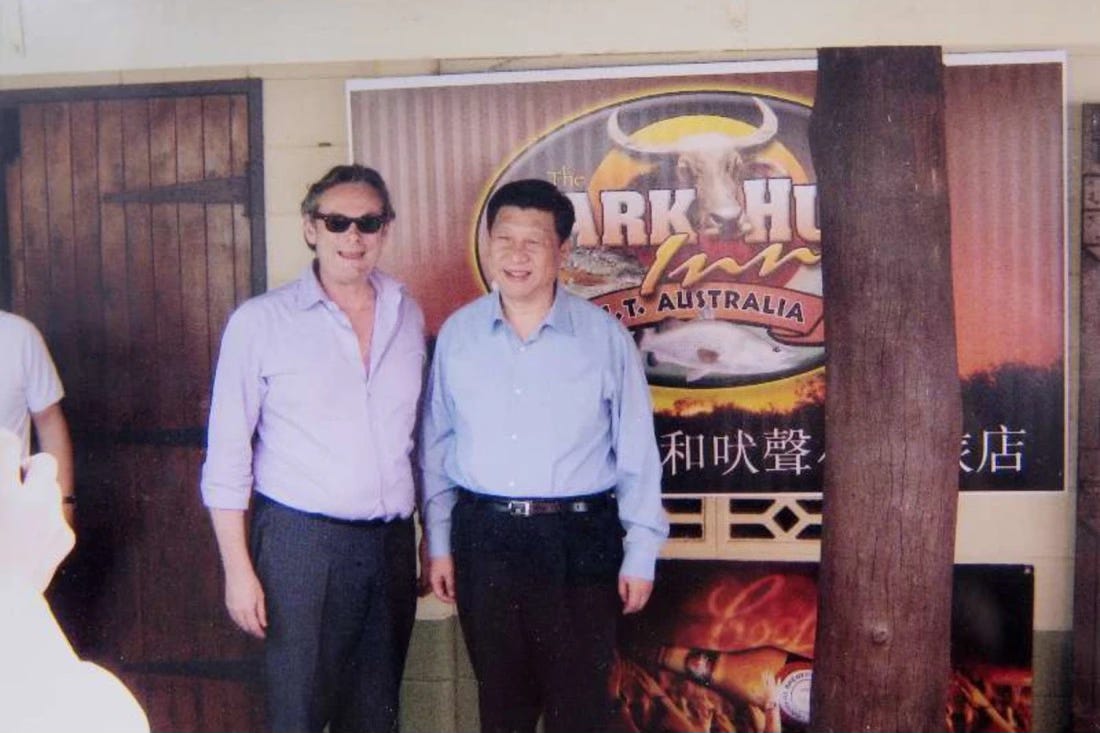Subimperial Notions
Professor James Curran sees unrestrained US influence over Australia's defence and foreign policy. Former Australian ambassador to China, Geoff Raby, sees Central Asia as a new "great game".
Australia remains an Atlanticist colonial outpost in Asia
Earlier this month, US air force fuel tankers flew from Australian airfields to refuel US B2 bombers heading to the Middle East to attack the Houthi rebels in Yemen who have been menacing Red Sea shipping.
Officials in Canberra offer an implied confirmation of this important strategic assistance to the US in the Middle East, saying that Australian support for the US strikes on Yemen on the night of October 16/17 included "access and overflight for US aircraft in northern Australia".
Security for our sea lanes is vital, that is not at issue. But this event is a further public example of the steady deepening of Australian military integration with the US armed forces, most of which flies largely under the radar.
The question remains whether there is any consideration of these facilities being a target for China, and how they are protected. Does the eventual stationing of US B52 bombers at Tindal, for example, increase Australia's vulnerability to attack, or, because of American self-interest, does it increase the likelihood of US protection?
China has incrementally, but deliberately, built its influence and dominance over Central Asia and beyond that to Eurasia more broadly. Its inexorable economic growth and, recently, Putin’s follies in the Ukraine have hastened China’s emergence as the preeminent power in the Eurasian heartland. China now finds itself in a similar geostrategic place as the US did at the end of the nineteenth century when it consolidated its borders and was able to establish hegemony over the Western Hemisphere. For the first time, China no longer need fear for its frontier security, other than from endemic Islamic fundamentalism. Rather than an ‘axis of authoritarian’ states between China and Russia, Russia is fast becoming a vassal state to China. In the West, the Chussia Anxiety is therefore misplaced. Far more important is China’s capacity, like the US a century ago, to project power globally. What will it do and what will it mean for regional geostrategic balance and for Australia’s place in the world?
BIO:
Geoff Raby was Australia’s Ambassador to China from 2007-11, during which he visited all provinces in China officially. He served in Beijing as First Secretary (Economic) and then Counsellor (Economic), 1986-91. He was Ambassador to the WTO in Geneva, Ambassador to APEC, and Deputy Secretary, 2003-07. He was also head of the Trade Policy Issues Division of the OECD, Paris, 1993-95. He is a non-executive independent director of ASX listed-companies Yancoal, where he chairs the Health, Safety, Environment and Community Committee, and sits on the Board of the Gavan Foundaton.
His most recent book, Great Game On: the contest for central Asia and global supremacy, was published by Melbourne University Press on 12 November 2024. His previous book was China’s Grand Strategy and Australia’s Future in the World Order (MUP Nov 2020). He regularly contributes op eds and travel writing to the Australian Financial Review. He holds a PhD in economics. He was awarded the Order of Australia (AO) in June 2019 for services to Australia-China bilateral relations and to multilateral trade.
https://www.npc.org.au/speaker/2024/1403-dr-geoff-raby-ao
The map that Canberra doesn’t want you to see
Australia’s military integration with the US proceeds apace, but is the Albanese government coming clean on the risks?
James Curran International editor Oct 27, 2024
Officials in Canberra offer an implied confirmation of this important strategic assistance to the US in the Middle East, saying that Australian support for the US strikes on Yemen on the night of October 16/17 included “access and overflight for US aircraft in northern Australia”.
The Pentagon’s first zone is the north of Australia, primarily in Washington’s eye the site for US “force projection”.
In this zone, Darwin and Katherine are key. In the territory capital, 2000 US marines rotate on six-month deployments. US aircraft, eventually including B52 bombers, are stationed at the Tindal airbase near Katherine.
But it would also include the coming upgrades to airfields across northern Queensland, the Northern Territory and Western Australia, at RAAF Scherger, Curtin and Learmonth bases.
The intelligence facilities at Pine Gap and North West Cape, so central to US war planning and the defence of the US itself, are also critical in this northern segment.
In the middle of the country, the US sees the potential for logistics hubs. While southern Australia, stretching from Perth across to south of Sydney, is the so-called “soft underbelly”, as some in the Pentagon apparently refer to it. This is for industrial production, comprising major population centres such as Melbourne, Perth and Adelaide that will support planned AUKUS submarine, frigate and munitions manufacture.
It has long been known just how critical Australia’s strategic geography is for American war fighting and deterrence of China.
This integration was laid out in the US-Australian agreements of 2011, on US marines in Darwin, and in 2014, on force posture. But American politicians state things far more bluntly.
In August the chairman of the US House of Representatives Foreign Affairs Committee, Michael McCaul, said Australia was “the central base of the Indo-Pacific to counter the [China] threat”.
The informed discussion that should be advising the Australian public of these significant details of our increasingly intimate alliance with the US is non-existent. There has been no public discussion in Australia about whether the US view of Australia’s newly provided offensive capability and centrality to US strategic doctrine is something to which the country should readily agree and whether it involves risks for Australia well beyond that which, from the time of the Cold War, flowed from hosting the joint intelligence facilities.
These are serious questions. While force projection clearly motivates American thinking, the question remains whether there is any consideration of these facilities being a target for China, and how they are protected. Does the eventual stationing of US B52 bombers at Tindal, for example, increase Australia’s vulnerability to attack, or, because of American self-interest, does it increase the likelihood of US protection?
Regardless, does Australia want such an involvement in a shooting war it may not have a say in fighting? Or did Pine Gap effectively answer that question in Washington and Canberra years ago?
Have these thoughts crossed the mind of the defence minister and the national security committee of cabinet? Unless the public is advised otherwise, the assumption must be no. There is after all no national security reason to not discuss these important issues with the Australian electorate. The US finds no difficulty in ventilating the realities of their Australian force projection.
Writing recently, former Defence bureaucrat Mike Pezzullo acknowledged that “US national war planning ... might already assume access to bases, infrastructure, logistics, pre-positioned materiel, and other support in Australia”.
Pezzullo was quick to add that there is “no public sign that Australia has encouraged any such assumptions”. But he also conceded “it might be that planning assumptions in Washington and Canberra differ to such an extent that each holds erroneous expectations of the other”. If that is indeed the case, then it puts a question mark over the very language if not purpose of “strategic alignment”. Current Defence officials will bristle at the very suggestion, but the point remains: their communications strategy is hamstrung by a studied refusal to countenance the kind of openness and transparency characteristic of their American counterparts.
Australia’s prominence in US war planning is now a critical part of a near-decade long project to disperse US military assets across the region. Washington is repurposing a series of World War II-era airfields and installations in the Western Pacific so that it has the capacity to move aircraft quickly away from their major military hubs at Kadena Air Base, in Okinawa, and Andersen Air Force Base, on Guam. US access to a greater number of airfields in the Philippines operates on the same principle.
This “scatter and survive” policy, as some media have termed it, is a strategic complement of the “latticework” system of alliances and partnerships in Asia that the US has structured since late last century.
The struts of the latticework criss-cross much of East Asia. But US military policy, although tightly woven into this strategy, is also stretching further south, away from the first and second island chain and towards Australia.
And it is at heart an attempt to make the targeting of US planes and ships more difficult in a conflict in the Taiwan straits.
There is sentiment at large in Australia that all this is similar to the circumstances around the American military presence in World War II. The critical difference, of course, is the Japanese attack on Pearl Harbour in December 1941. That brought the US into the war, and it was from that decision that American military forces came in strength to Australia.
But Australia is now involved in contingency planning for a war of undefined provocation or cause.
A bigger US footprint here does not equate with a greater say in the making of policy, or access to the innermost American war councils. As John Curtin and Bert Evatt found out in the years from 1943-1945.
Public discussion of these issues is surely necessary to gain the electorate’s agreement to the policy of deeper integration with the US.
What is similar to the Second World War is the meaningful comment American General Douglas MacArthur made to his British liaison officer in October 1942, that when he had arrived from the Philippines earlier that year, “Curtin and Co more or less offered him the country on a platter”.
If there is a historical analogy to be drawn it is also surely to recall the words of the then American minister in Canberra: the Australian “seeming to expect us to do everything for him, fight for him and work for him”. An Australian, he judged, was a creature incapable of “seeing beyond his surfing beaches”.
US policy planners may well have already assessed that Australia’s best contribution to any future war effort is as it was in 1941: the full and unimpeded resources of the Australian continent. Rather than any genuine contribution to the frontline.
There is astute judgment in the American policy of dispersing its assets to make them harder to hit. It is also not difficult to see why, given the ready agreement of successive Australian governments, that the Pentagon would assume full access to Australian continental resources. But no Australian government over the last decade and a half has taken the time to explain this policy, and its risks, to the Australian people.









